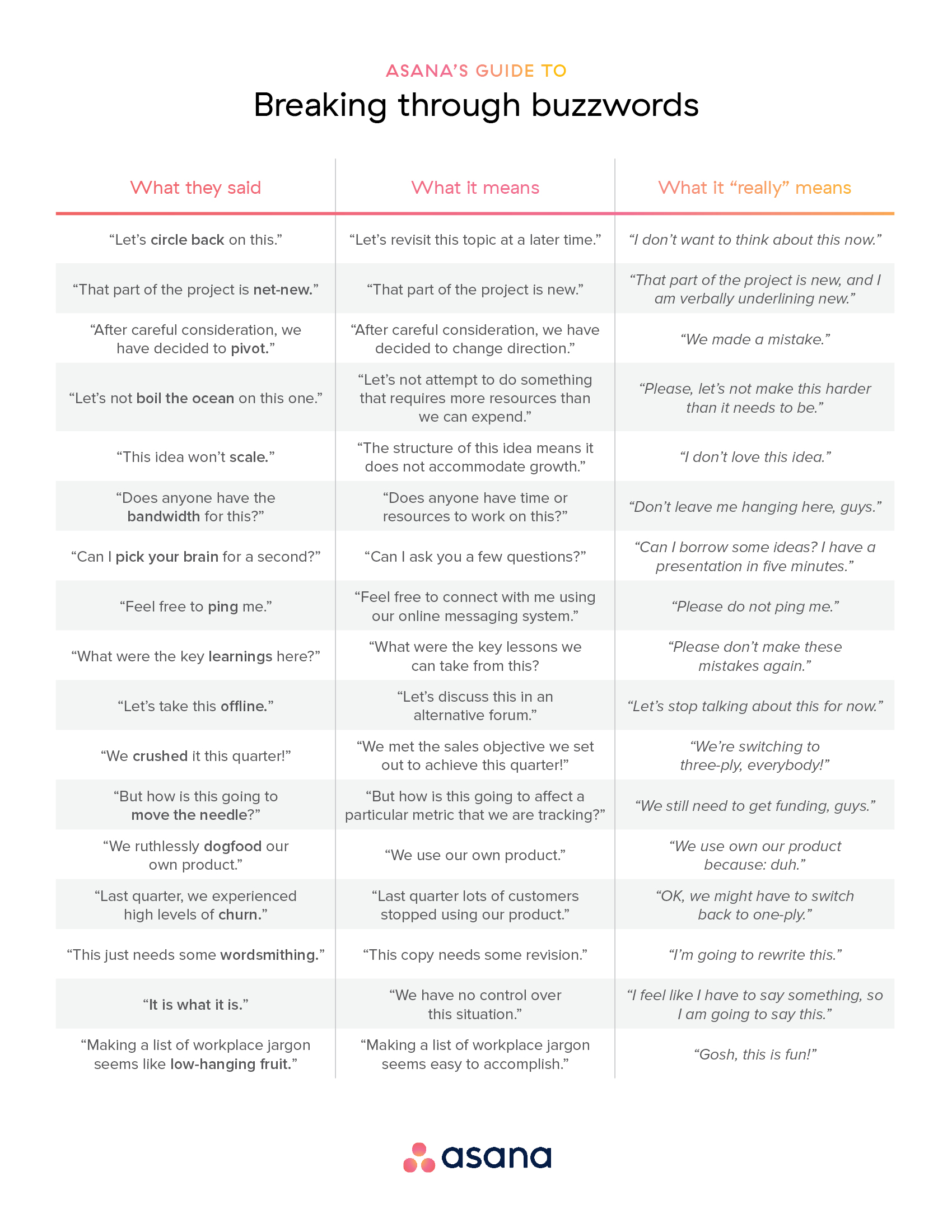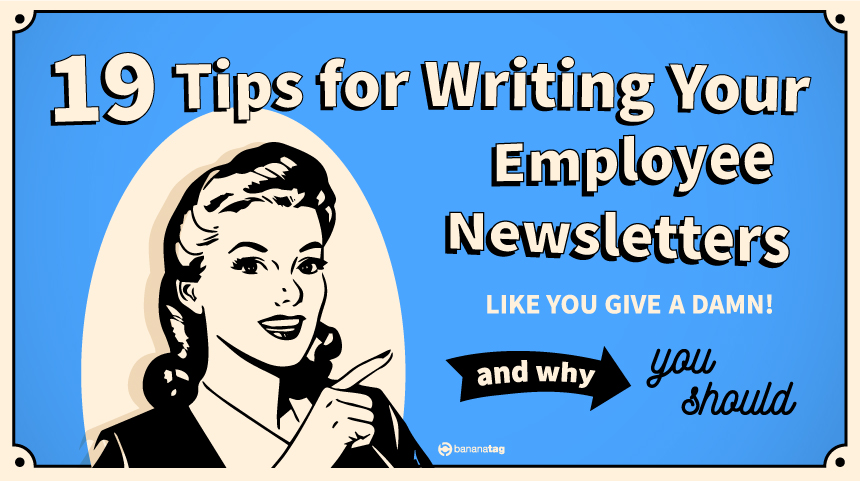1. Write for one person
Even if you’re communicating to 10,000 employees, just write for one.
You can do this by stylistically shifting your written voice or by simply using the pronoun “you.” This style of writing triggers our sense of identification, so we start looking for ourselves in the content, and naturally find it more interesting. It also feels more personal.
Say this: Coming in 2022, there will be some changes to your health benefits account. We’ve secured HealthCorp to take over our employee benefits plan, so we can provide you with even better health services. For more details, you can speak to your manager or contact HR.
2. Write in the first person (us, we, me, I)
Writing in the first person gives your reader a sense that they are engaging with a person, not a robot. It also personalizes, softens, and warms your content. These words pull us in and make us feel more involved and connected.
Instead of this: Acme Corp is proud to announce the opening of five new branches across the US.
Say this: The Acme Corp family is growing, and we are proud to announce that five new branches will be joining us in the coming year.
3. Banish jargon and big words
A good way to alienate your readers is to confuse them, or make them feel stupid for not knowing the words you’re using.
There is a ton of jargony business language out there, and each organization will also have its own unique lexicon of jargon that people throw around.
So don’t do it.
Here are 150 jargon words and some suggestions for fixing them. Here are 50 more.
Asana also has some helpful examples:

4. Use contractions
Most words that can be contracted should be contracted. It will — sorry — it’ll make your writing more readable and relatable.
5. Shorten your sentences
Have you ever started reading a sentence and by the end of it you’ve forgotten what it’s even about?
When reading corporate newsletters, it happens a lot.
Generally speaking, the longer your sentence, the harder it is to read. Each sentence should contain just one thought.
By following this rule your content will be easier to understand and less time consuming to read.
6. Make it easy to read
Your newsletter design is a big factor in the readability of your writing. Because the last thing people want to do is decipher a dense block of text.
If your sentences are packed together in a long paragraph, people’s eyes will skip right over them. It’s just how people read things. (Blame social media.)
Give your sentences room to breathe. Heck, give them their own paragraph if you think it’ll help them stand out.
Think white space, white space, and more white space.
Here, you’ll find a great internal newsletter template goes a long way.
7. Break the rules
I know, I’ve already asked you to break a lot of rules.
And if you’re a grammar nerd, you’re probably already thinking, no way, not in a million years am I doing any of this. Well, you and your high school English teacher are going to hate what I have to say next.
Broken sentences are okay.
Starting a sentence with “and,” “but,” and “or,” is okay.
One sentence paragraphs are totally legit.
Why am I suggesting you toss out all this deeply entrenched grammar wisdom you’ve learned?
Because real people rarely speak in grammatically correct sentences.
If you’ve ever had to write or edit a transcript, you know that even the most educated of us don’t speak with perfect grammar.
And the way we read has radically changed. We skim, skip, and jump around. Breaking some of the more boring grammar rules is a fun way to spice up our writing and make it more interesting and relatable.
So as long as the meaning of your sentence remains clear, go ahead and break the rules.
8. Write in the active tense
In the active voice, the subject of a sentence performs an action.
In the passive voice, the subject receives an action.
Active: Staffbase threw a fantastic party.
Passive: A fantastic party was thrown by Staffbase.
Which one sounds more conversational?
Communicators often blunder over the passive tense. When written, it sounds more authoritative and professional.
But when read, it’s cumbersome, cold, and kinda stuffy.
Hint: To find and weed out passive voice sentences look for the word “by.”
9. Remove non-essential information
Every word, and by extension, every sentence, needs a purpose.
If the word does nothing, don’t include it.
If the sentence doesn’t give the reader any real information, don’t include it.
Blabbering on to your audience will lose their attention. If they don’t feel like they’re getting value or new information from each sentence, they’re likely to skip over them.
And if they start skipping one or two sentences, next they’ll be skipping whole paragraphs.
That’s pretty dangerous if you’re actually trying to convey important information in your writing, which I assume you are.
10. Don’t use clichés
If you start a sentence with, I know it’s cliché but . . .
Stop. Delete. Try again.
Not only are clichés tired and lazy, they’re also unclear. If you’re communicating with a workforce that isn’t from your part of the world, it’s likely these phrases will be completely lost on them and only increase confusion.
If you can stomach it, here are some examples:
- When life gives you lemons, make lemonade.
- A journey of a thousand miles begins with the first step.
- A picture is worth a thousand words.
- Caught between a rock and a hard place.
- Don’t throw the baby out with the bath water.
- Genius is one percent inspiration and 99 percent perspiration.
- I have not failed. I’ve just found 10,000 ways that won’t work.
- The definition of insanity is doing the same thing over and over again and expecting different results.
- Where there’s a will, there’s a way.
- Failing to prepare is preparing to fail.
That was painful… let’s move on.
11. Ask questions
Whether rhetorical or serious, questions help put readers in a receiving and thoughtful mindset. When we see a question mark, we’re inclined to keep reading and see what comes next.
Questions can also help you structure your writing so that when you introduce a piece of information, you can answer the audience’s concerns right away.
Examples:
- Curious about that noise on the second floor?
- What does it mean to be a member?
- Have you used your benefits yet?
- How does this affect you?
This makes your writing more relatable and gives it a more helpful tone.
12. Care
If you don’t care who you’re writing for, or what you’re writing about, you have no right to demand that your readers care!
If it’s impossible to relate to the content (because hey, we don’t always have control over what leadership wants communicated), use questions that give the reader some context. (See previous tip.)
Sure, lots of corporate content is super boring. But there’s a reason it needs to be communicated. Find that reason and show your readers why they should care.
13. Focus on the reader
It’s hard to have a good conversation if neither person wants to talk about the subject at hand. The same principle applies to conversational writing.
You’re writing for employees, so focus your messaging around what they want to hear.
Ask yourself, will my readers care about this? If not, find a way to reframe the information so your audience can better understand how it’s relevant to them. Either that or don’t include it at all.
14. Don’t be self-important
It’s easy to go overboard on formalities in the name of professionalism.
In corporate communications, it’s especially easy to make something sound more important than it is.
But you won’t inspire people to care about something by using bigger words or long introductions.
Be real with people — and be concise. When you ramble on in corporate speak, you aren’t respecting your readers’ time.
Instead of this: As a component of the effort, we will orchestrate to focus the congruous business model approach for our sales markets while striving to offer our products in all markets with a vigorous fixation on maintaining business continuity.
Try this: To adjust to these changes, we will be focusing on evaluating our business models in each of these markets.
15. Be realistic
Look at your sentences and word choice. If what you’ve written would never come out of someone’s mouth in a conversation (it’s too verbose or the tone is too formal), try again.
16. Study conversations
If you want to be the best at conversational writing, you’re going to have to familiarize yourself with the nature of conversations.
So put on your anthropologist hat and start observing. Notice how people around you are speaking. What kind of details concern them? What are the qualities that make one conversation good and satisfying, and another bad or boring?
Next, get some practice. If you have a particularly challenging topic you have to write about, like an IT update, talk about it with someone. Try and explain to them what it is and why it is important.
If you can’t do that, have someone explain the topic to you. Notice how their tone and word choice differs from the language used in the official memo or information source.
Starting now, whenever you’re having a professional conversation at work, note how information is contextualized, the words that are used, and the tone.
As you familiarize yourself with the nature of conversations, you’ll find it easier to bring this style and tone to your writing.
17. Read more conversational writing
Reading conversational writing is a great way to familiarize yourself with the style and become more comfortable using it.
Browse through people’s personal blogs or search platforms like Medium to find writers that nail that professional yet conversational tone.
Here are some great conversational writers:
18. Edit out loud
Read all of your writing out loud. If it sounds weird or clunky coming out of your mouth, it’s going to sound weird in your reader’s head.
19. Be human
The easiest way to make your writing more conversational, while still remaining professional, is to humanize your writing.
This means talking about more than just facts and figures. Talk about thoughts and feelings. Remind your readers that there’s a person on the opposite side of the screen. And talk to them like you know they’re people too.
Example
Robot: PTO Policy Changes are currently under review.
Human: We’re excited to announce there are some major PTO Policy Changes coming that will help our employees maintain a better work-life balance.
Should all my writing be conversational?
Conversational writing is more engaging, and frankly, more fun to write. This may tempt you to make all of your internal comms content more conversational.
But keep in mind that a conversational tone may not translate on all platforms, nor to all audiences. In reports, alerts, policies, and some executive communications, it may be best to keep your writing purely informational or formal.
And in the end, no matter how professional, a conversational tone may not be appropriate for your organization or audience. It’s important for you to use your judgment and be open to feedback.
The power of conversational writing
Once you start writing in a more conversational tone, you’ll get a lot of feedback.
Generally, this feedback will be positive. Because conversational writing is more interesting and easy to read, employees will relate to it and take it more personally. And when this happens, you’ll see your employee newsletter engagement soar.
You may even hear from employees that the newsletter helps them feel more included or excited about their work.
This is where the real power of conversational writing lies.
Conversational writing humanizes your organization.
Creating a more human experience for your employees will help spark more conversations and facilitate more open communication.
People will feel better and more comfortable about opening up, giving feedback, and sharing their stories and experiences. And this level of comfort and connection can help employees feel more invested in their work, creating a more engaged workforce.
Conversational writing is a simple yet powerful tool that can help you create a better employee experience, and in turn, help your organization meet engagement goals and business objectives.
Have you tried a conversational tone in your employee content? Why or why not? Has using a more conversational tone helped your internal communications?
Share your experience in Comms-unity, our global Slack community for internal communicators.



